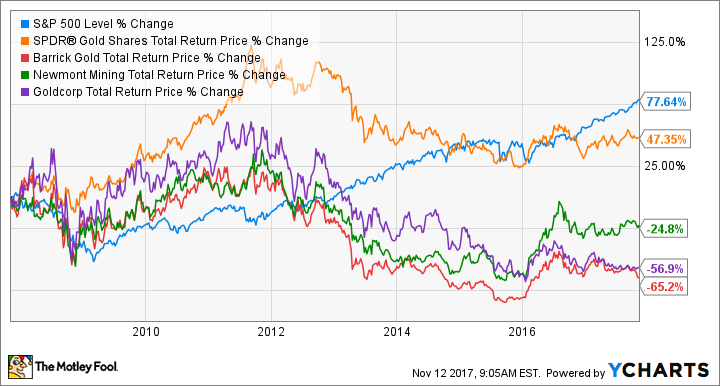3 Gold Stocks You Don't Have to Babysit
One of the most common precepts in investing is that each investor, regardless of age, should have a mix of conservative and aggressive stocks. Every portfolio should have a little niche carved out for investments that are most likely to withstand the market's whims. And of the usual suspects that can serve this purpose, gold is often recommended as the best choice, providing a hedge against market volatility.
Playing it safe
The most conservative approach to gaining exposure to the metal is through a gold ETF. The objective of the SPDR Gold Trust ETF (NYSEMKT: GLD), for example, is to track the price of gold. Instead of holding companies, the gold ETF includes physical gold, and occasionally cash, as its holdings.

Image source: Getty Images.
In the short term, it's certainly possible that a gold miner can beat the S&P 500, but our time horizon is much longer. Consider the largest gold miners by market cap: Barrick Gold (NYSE: ABX), Newmont Mining Corp. (NYSE: NEM), and Goldcorp (NYSE: GG).
Not only have the gold miners failed to match the performance of the S&P 500, but they have also underperformed the gold ETF. Even more concerning is that they haven't even produced positive returns.
Over the long term, it's unlikely that shares of the ETF will produce market-beating results, and some may argue that it's a poor choice since it's not interest-bearing and doesn't offer a dividend. However, it is an option that's likely to produce positive returns in the long term. Moreover, since many investors flock to gold when there's market volatility or precipitous declines, those with positions in the gold ETF can rest assured that it's one corner of their portfolios that doesn't require close supervision.
A brief, but golden, lesson in finance
Besides an ETF, another viable choice is a royalty and streaming company. Unlike miners that dig the yellow stuff out of the ground, these companies are essentially financiers, providing up-front payments to the miners. In exchange, they receive the rights to purchase the mined metal at a preset price or to receive a percentage of mineral production. Since they're not directly involved with the mining of the mineral, they're not burdened with the weighty operating costs the miners incur. Furthermore, dips in the price of gold don't adversely affect the companies as much as it does gold miners, those who own bullion, or investors in gold ETFs.
Although there aren't many choices when it comes to investing in royalty and streaming companies, there are two noteworthy names: Royal Gold (NASDAQ: RGLD) and Franco-Nevada (NYSE: FNV). Although both companies have portfolios consisting of multiple minerals, Royal Gold and Franco-Nevada primarily make their hay from gold. In terms of fiscal 2016 revenue, for example, Royal Gold and Franco-Nevada reported that gold accounted for 85% and 70%, respectively.
Of course, the past performances of the two stocks are no guarantee that they will perform similarly in the future. But it's certainly worth taking a gander.
RGLD Total Return Price data by YCharts.
Looking back nearly 10 years (bearing in mind that Franco-Nevada's IPO was less than 10 years ago), we find both companies have produced market-beating returns. But this is hardly enough to justify an investment. So let's turn to their fundamentals.
For one thing, both companies have demonstrated the ability to generate consistent operational cash flows. According to Morningstar, Franco-Nevada has grown its cash from operations at a compound annual growth rate (CAGR) of 85%. And although Royal Gold has only grown its operational cash flow at a 21% CAGR over the same period, the company, whose fiscal year ends in June, reported a company record for operational cash flow in fiscal 2017.
Presumably, there's greater growth ahead for each company, for they both have portfolios that contain assets operated by industry-leading gold miners, mitigating the risk that any one company will falter. Royal Gold, for example, has 39 assets currently producing minerals and 22 assets in development. Combined with the other projects in varying phases of development, it has 195 property interests. Franco-Nevada's portfolio, likewise, is nothing to sneeze at. Including the 47 assets producing minerals, it has 260 mineral property interests. In addition, it has 80 oil and gas assets to its name.
Another factor to take into consideration is liquidity. Besides a well-diversified portfolio, each company seems well suited to survive a rapid downturn in the price of gold. As of the most recent quarter, Royal Gold has a quick ratio of 3.62, while Franco-Nevada's quick ratio is a whopping 19.46.
Investor takeaway
Any investor worth his salt knows there are no guarantees. Nonetheless, gold-oriented options, like the SPDR Gold Trust ETF, Royal Gold, and Franco-Nevada, provide strong assurances that even if left unattended for a lengthy amount of time, they will be OK. With no exposure to companies, the gold ETF provides a conservative approach to the yellow metal. With histories of strong cash flows, well-diversified portfolios, and ample liquidity, Royal Gold and Franco-Nevada offer investors compelling opportunities.
More From The Motley Fool
6 Years Later, 6 Charts That Show How Far Apple, Inc. Has Come Since Steve Jobs' Passing
Why You're Smart to Buy Shopify Inc. (US) -- Despite Citron's Report
Scott Levine has no position in any of the stocks mentioned. The Motley Fool has no position in any of the stocks mentioned. The Motley Fool has a disclosure policy.

 Yahoo Finance
Yahoo Finance 

